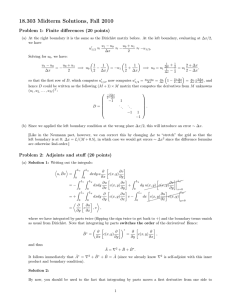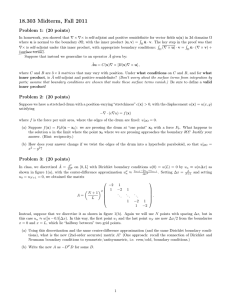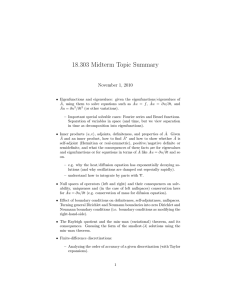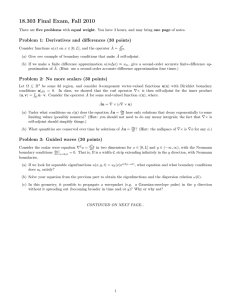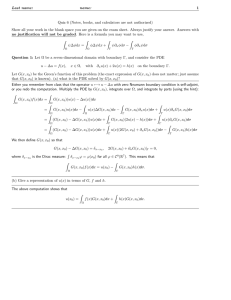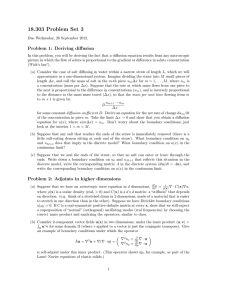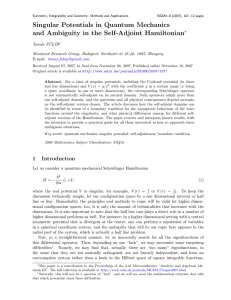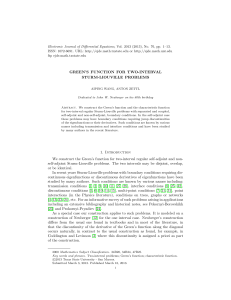18.303 Problem Set 3 Solutions Problem 1: (5+5+10)
advertisement
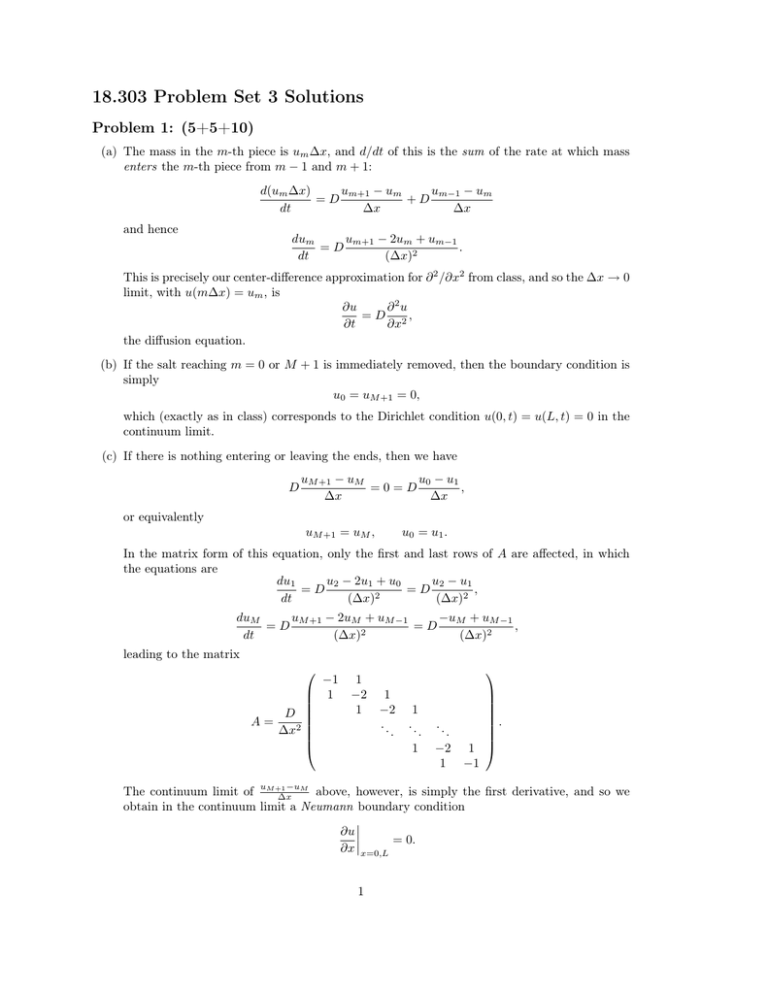
18.303 Problem Set 3 Solutions
Problem 1: (5+5+10)
(a) The mass in the m-th piece is um ∆x, and d/dt of this is the sum of the rate at which mass
enters the m-th piece from m − 1 and m + 1:
um+1 − um
um−1 − um
d(um ∆x)
=D
+D
dt
∆x
∆x
and hence
dum
um+1 − 2um + um−1
.
=D
dt
(∆x)2
This is precisely our center-difference approximation for ∂ 2 /∂x2 from class, and so the ∆x → 0
limit, with u(m∆x) = um , is
∂u
∂2u
= D 2,
∂t
∂x
the diffusion equation.
(b) If the salt reaching m = 0 or M + 1 is immediately removed, then the boundary condition is
simply
u0 = uM +1 = 0,
which (exactly as in class) corresponds to the Dirichlet condition u(0, t) = u(L, t) = 0 in the
continuum limit.
(c) If there is nothing entering or leaving the ends, then we have
D
uM +1 − uM
u0 − u1
=0=D
,
∆x
∆x
or equivalently
uM +1 = uM ,
u0 = u1 .
In the matrix form of this equation, only the first and last rows of A are affected, in which
the equations are
du1
u2 − 2u1 + u0
u2 − u1
=D
=D
,
2
dt
(∆x)
(∆x)2
uM +1 − 2uM + uM −1
−uM + uM −1
duM
=D
=D
,
2
dt
(∆x)
(∆x)2
leading to the matrix
−1
1
D
A=
∆x2
1
−2
1
1
−2
..
.
1
..
.
1
..
.
−2
1
.
1
−1
−uM
above, however, is simply the first derivative, and so we
The continuum limit of uM +1
∆x
obtain in the continuum limit a Neumann boundary condition
∂u = 0.
∂x x=0,L
1
Problem 2: (10+10)
(a) To show that we have orthogonal modes with real frequencies, using the result from class for
general hyperbolic equations, we just need to show that  is self-adjoint and negativedefinite. In particular, for  = ρ1 ∇ · C∇, as in class we want an inner product that cancels
the 1/ρ factor:
ˆ
hu, vi =
ρūv .
Ω
´
‚
´
Using the same integration-by-parts rule as in class Ω f ∇ · g = ∂Ω f g · ds − Ω g · ∇f, we
then find:
ˆ
‹
ˆ
1
hu, Âvi =
∇
·
C∇v
=
ρ
ū
ūC∇v
·
ds
−
C∇v · ∇ū
|{z}
| {z } Ω
∂Ω
Ω
ρ g
f
ˆ
ˆ
ˆ
= − (C∇v)T ∇u = − (∇v)T C T ∇u = − (∇v)T C∇u
Ω
‹
ˆ Ω
ˆΩ
· ds +
vC∇u
v · ∇ · C∇u
∇ |{z}
v ·C∇u
=−
| {z } = −
∂Ω
Ω
Ω
=
g
f
ˆ
1
ρ ∇ · C∇u · v = hÂu, vi,
Ω ρ
hence  is self-adjoint. Here, in the second line we have used the fact that a dot product
of two vectors is really g · h = gT h in linear-algebra notation, which allows us to use the fact
that C T = C = C̄. The boundary terms vanish because u and v are zero at the boundaries.
Furthermore, negative-definiteness is obtained by inspection of the second line:
ˆ
hu, Âui = − (∇u)∗ C(∇u),
Ω
where ∗ is the conjugate-transpose. C is given to be positive-definite, so (∇u)∗ C(∇u) > 0 for
∇u 6= 0 by definition, but ∇u = 0 ⇐⇒ u = constant ⇐⇒ u = 0 by the boundary conditions,
and hence hu, Âui < 0 for u 6= 0 and  is negative-definite as desired.
(b) For example, the Dirichlet boundary condition u|∂Ω = 0 is sufficient. (Other possibilities
include periodic boundary conditions, if Ω is a parellelogram, or Neumann-like boundary conditions n · ∇u|∂Ω = 0 and ∇ · u|∂Ω = 0, i.e. that the normal derivative of each component of
u vanishes at the boundary along with the divergence of u.)
To see this, consider
ˆ
ux ∇2 ux + uy ∇2 uy + u · ∇(∇ · u) .
hu, Âvi =
Ω
2
The first two ∇ are self-adjoint with Dirichlet boundaries
by exactly
the proof
´
‚
´ from class.
The third term proceeds analogously, using the same Ω f ∇ · g = ∂Ω f g · ds − Ω g · ∇f rule:
ˆ
‹
ˆ
u ·∇ (∇ · v) = (∇· v)u · ds − (∇ · |{z}
v )∇
|{z}
| {z· u}
| {z } ∂Ω
Ω
Ω
g
f
g
‹
f
ˆ
(∇· u)v · ds +
∇(∇ · u) · v,
= − ∂Ω
Ω
where we have integrated by parts twice, and hence hu, ∇(∇ · v)i = h∇(∇ · u), vi as desired.
2
Problem 3: (10+10)
(a) I used the following code. Note that M is a 5 × 5 matrix, but K is a 6 × 6 matrix (since
there are 6 springs for 5 masses). All of the eigenvalues [diag(S)] are indeed real, and the
eigenvectors are orthogonal as verified by the fact that V ∗ M V has zero offdiagonal elements
(up to roundoff errors ≈ 10−15 ):
Ddx = diff1(5);
M = diag([1 2 3 4 5]);
K = diag([6 5 4 3 2 1]);
A = -inv(M) * Ddx’ * K * Ddx;
[V,S] = eig(A);
diag(S)
ans =
-12.59560
-4.25113
-1.86565
-0.78303
-0.18793
V’ * M * V
ans =
1.0955e+00
8.5167e-16
2.1469e-16
1.0274e-16
-2.7274e-17
8.4354e-16
2.0799e+00
-2.1447e-15
-1.3782e-15
4.4169e-16
2.1948e-16
-2.1329e-15
2.8931e+00
-5.0491e-16
2.8168e-16
1.0228e-16
-1.2613e-15
-5.1825e-16
3.4751e+00
1.3080e-15
-3.0413e-17
3.8557e-16
3.6597e-16
1.2537e-15
3.9021e+00
(b) For A = V ΛV −1 , real Λ = Λ∗ , W = (V V ∗ )−1 = V −∗ V −1 [where V −∗ denotes (V ∗ )−1 =
(V −1 )∗ ], and hx, yiW = x∗ W y, we have:
hx, AyiW = x∗ V −∗
V −1
V ΛV −1 y = (V −1 x)∗ Λ∗ V −1 y
= (ΛV −1 x)∗ V −1 y = (ΛV −1 x)∗
V ∗
V −∗ V −1 y
= (V ΛV −1 x)∗ V −∗ V −1 y = hAx, yiW ,
so A is self-adjoint.
However, if we compute this in Matlab from above, using W = inv(V*V’), we do not get
W = M . In fact, W is not even a diagonal matrix. The reason is that the choice of eigenvectors V , and hence the choice of W = (V V ∗ )−1 , is not unique: even if the eigenvalues
have multiplicity 1 (as they do here), we can multiply the eigenvectors by any scale factor
we want, which corresponds to transforming V → V Σ for some diagonal scaling matrix Σ,
and hence transforming W → (V ΣΣ∗ V ∗ )−1 . Matlab, particular, defaults to normalizing its
eigenvectors v so that v ∗ v = 1, whereas to get W = M we would need to normalize them so
that v ∗ M v = 1.
3
